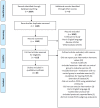A Systematic Review of the Effects of Exercise on Hormones in Women with Polycystic Ovary Syndrome
- PMID: 33467251
- PMCID: PMC7739243
- DOI: 10.3390/jfmk5020035
A Systematic Review of the Effects of Exercise on Hormones in Women with Polycystic Ovary Syndrome
Abstract
Background: Polycystic ovary syndrome (PCOS) is a common endocrine disorder that is characterized by menstrual irregularity and elevated serum androgens, and is often accompanied by insulin resistance. The etiology of PCOS is unknown. Lifestyle interventions and weight loss, where appropriate, remain first-line treatments for women with PCOS. Regular physical activity is recommended for women with PCOS to maintain a healthy weight and cardiovascular fitness.
Purpose: To review the evidence for the impact of various exercise interventions on hormone levels in women with PCOS.
Methods: A systematic review of original studies indexed in PubMed that utilized an exercise intervention in women with PCOS and reported hormone values pre- and post-intervention. Studies in which the effects of the exercise intervention could be determined were included.
Results: Vigorous aerobic exercise improves insulin measures in women with PCOS. Resistance or strength training may improve androgen levels, though additional studies are warranted. Studies with yoga are limited but suggest improvements in androgens. Limited information is available on the impact of exercise on adipokines and anti-Müllerian hormone, warranting further investigation.
Conclusions: Recommended guidelines for women with PCOS include vigorous aerobic exercise and resistance training to improve measures of insulin sensitivity and androgen levels.
Keywords: PCOS; adipokines; androgens; hyperandrogenism; insulin resistance; obesity; physical exercise.
Conflict of interest statement
The authors declare no conflict of interest. The funders had no role in the design of the study; in the collection, analyses, or interpretation of data; in the writing of the manuscript, or in the decision to publish the results.
Figures
Similar articles
-
Lifestyle intervention up-regulates gene and protein levels of molecules involved in insulin signaling in the endometrium of overweight/obese women with polycystic ovary syndrome.Hum Reprod. 2014 Jul;29(7):1526-35. doi: 10.1093/humrep/deu114. Epub 2014 May 19. Hum Reprod. 2014. PMID: 24842895
-
Thiazolidinediones for the therapeutic management of polycystic ovary syndrome : impact on metabolic and reproductive abnormalities.Treat Endocrinol. 2006;5(3):171-87. doi: 10.2165/00024677-200605030-00005. Treat Endocrinol. 2006. PMID: 16677059
-
Polycystic ovary syndrome and anti-Müllerian hormone: role of insulin resistance, androgens, obesity and gonadotrophins.Clin Endocrinol (Oxf). 2014 Dec;81(6):899-906. doi: 10.1111/cen.12557. Epub 2014 Sep 1. Clin Endocrinol (Oxf). 2014. PMID: 25040369
-
Lifestyle management in polycystic ovary syndrome - beyond diet and physical activity.BMC Endocr Disord. 2023 Jan 16;23(1):14. doi: 10.1186/s12902-022-01208-y. BMC Endocr Disord. 2023. PMID: 36647089 Free PMC article. Review.
-
Exercise Interventions in Polycystic Ovary Syndrome: A Systematic Review and Meta-Analysis.Front Physiol. 2020 Jul 7;11:606. doi: 10.3389/fphys.2020.00606. eCollection 2020. Front Physiol. 2020. PMID: 32733258 Free PMC article.
Cited by
-
Current Perspectives on Nonalcoholic Fatty Liver Disease in Women with Polycystic Ovary Syndrome.Diabetes Metab Syndr Obes. 2022 Apr 24;15:1281-1291. doi: 10.2147/DMSO.S362424. eCollection 2022. Diabetes Metab Syndr Obes. 2022. PMID: 35494531 Free PMC article. Review.
-
Tai Chi for Overweight/Obese Adolescents and Young Women with Polycystic Ovary Syndrome: A Randomized Controlled Pilot Trial.Evid Based Complement Alternat Med. 2022 Jun 17;2022:4291477. doi: 10.1155/2022/4291477. eCollection 2022. Evid Based Complement Alternat Med. 2022. PMID: 35754690 Free PMC article.
-
HIIT'ing or MISS'ing the Optimal Management of Polycystic Ovary Syndrome: A Systematic Review and Meta-Analysis of High- Versus Moderate-Intensity Exercise Prescription.Front Physiol. 2021 Aug 16;12:715881. doi: 10.3389/fphys.2021.715881. eCollection 2021. Front Physiol. 2021. PMID: 34483969 Free PMC article.
-
Mechanisms and Target Parameters in Relation to Polycystic Ovary Syndrome and Physical Exercise: Focus on the Master Triad of Hormonal Changes, Oxidative Stress, and Inflammation.Biomedicines. 2024 Mar 1;12(3):560. doi: 10.3390/biomedicines12030560. Biomedicines. 2024. PMID: 38540173 Free PMC article. Review.
-
Polycystic Ovary Syndrome in Insulin-Resistant Adolescents with Obesity: The Role of Nutrition Therapy and Food Supplements as a Strategy to Protect Fertility.Nutrients. 2021 May 28;13(6):1848. doi: 10.3390/nu13061848. Nutrients. 2021. PMID: 34071499 Free PMC article. Review.
References
-
- Zawadski J.K., Dunaif A. Diagnostic Criteria for Polycystic Ovary Syndrome: Towards a Rational Approach. Blackwell Scientific Publications; Boston, MA, USA: 1992.
Publication types
Grants and funding
LinkOut - more resources
Full Text Sources
Medical


